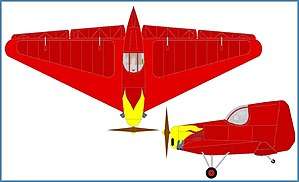Chyeranovskii BICh-20
The BICh-20 Pionyer was a tail-less research aircraft designed and built in the USSR from 1937.
| BICh-20 Pionyer | |
|---|---|
 | |
| Role | Research |
| National origin | USSR |
| Manufacturer | Chyeranovskii |
| Designer | Boris Ivanovich Chyeranovskii |
| First flight | early 1938 |
| Number built | 1 |
Development
Chyeranovskii's smallest aircraft was the BICh-20 Pionyer, following broadly similar lines to its predecessors, the airframe was constructed of wood with a low aspect ratio tapered wing carrying suspended ailerons and flaps at the trailing edge. The engine and pilot were accommodated in the central nacelle with the cockpit canopy forming the leading edge of the broad chord fin and rudder. Flight tests were carried out, with ski undercarriage from early 1938, to investigate the turning performance of the tail-less designs, particularly in flat horizontal flight without banking. Tests demonstrated turns up to 35 deg while the wings remained horizontal. The initial 18 hp Blackburne Tomtit was replace with a 20 hp Aubier-Dunne in the latter half of 1938
Specifications (BICh-20 Aubier-Dunne)
Data from Gunston, Bill. “The Osprey Encyclopaedia of Russian Aircraft 1875 – 1995”. London, Osprey. 1995. ISBN 1-85532-405-9
General characteristics
- Crew: 1
- Length: 3.56 m (11 ft 8-1/4 in)
- Wingspan: 6.9 m (22 ft 8 in)
- Wing area: 9 m2 (97 ft2)
- Empty weight: 181 kg (399 lb)
- Gross weight: 287 kg (633 lb)
- Powerplant: 1 × Aubier-Dunne, 14.9 kW (20 hp)
Performance
- Maximum speed: 166 km/h (103 mph)
- Range: 320 km (199 miles)
- Service ceiling: 4,000 m (13,120 ft)
Armament
See also
Aircraft of comparable role, configuration and era
Related lists
References
- Gunston, Bill. “The Osprey Encyclopaedia of Russian Aircraft 1875 – 1995”. London, Osprey. 1995. ISBN 1-85532-405-9
External links
| Wikimedia Commons has media related to Cheranovsky BICh-20. |